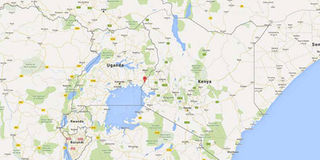'Big Brother' on the lookout for crowded areas

Google Maps. Google launched mobility reports that can be used by law enforcers and health workers to enforce social distancing measures. PHOTO | FILE | NATION MEDIA GROUP
What you need to know:
- Health Cabinet Secretary Mutahi Kagwe continues to appeal to Kenyans to stay indoors and abide by social distance requirements.
- In Kenya, the first report shows a 45 per cent decline in visits to restaurants, cafes, shopping centres, theme parks, museums, libraries, and movie theatres.
The government now has access to data that can point out crowded areas, making it the latest tool in the fight against the deadly Covid-19 disease.
This is after Google launched mobility reports that can be used by law enforcers and health workers to enforce social distancing measures.
The American technology company said the aggregated and anonymised data from its Google Maps is part of its contribution to the global fight against the pandemic.
The data can show where there are huge crowds, which attract greater risks of transmission, allowing authorities information to intervene in good time.
The reports will chart movement trends over time by geography, across different high-level categories of places such as retail and recreation, groceries and pharmacies, public transport termini, workplaces, and residential areas.
CONTACT TRACING
For instance, this information can help officials understand changes in essential trips that can shape recommendations on business hours or inform delivery service offerings.
“Similarly, persistent visits to transportation hubs might indicate the need to add additional buses or trains in order to allow people who need to travel room to spread out for social distancing,” Google said in a statement.
“Ultimately, understanding not only whether people are travelling, but also trends in destinations, can help officials design guidance to protect public health and essential needs of communities.”
But it is set to give Big Brother another tool to use in its technology-based spying that has helped track down offenders and those not abiding by the self-quarantine requirements.
Already, Kenya is using mobile supported phone triangulation to tell the movements of suspects and track down their contacts.
Health Cabinet Secretary Mutahi Kagwe continues to appeal to Kenyans to stay indoors and abide by social distance requirements.
MOBILITY REPORTS
Some of these appeals have fallen on deaf ears even as the country crossed the 100 positive cases mark last week.
Google says public health officials have indicated that aggregated, anonymised data could be helpful as they make critical decisions to combat the virus, which is devastating economies around the world and locking down millions of people in their homes.
The search engine giant will be publishing Covid-19 community mobility reports to provide insights into what has changed in response to work from home, shelter in place, and other policies aimed at flattening the curve of the Covid-19 pandemic.
The firm assured its online customers that the reports have been developed to be helpful while adhering to Google’s stringent privacy protocols and policies.
“While Google displays a percentage point increase or decrease in visits, it will not share the absolute number of visits. To protect people’s privacy, no personally identifiable information, like an individual’s location, contacts or movement, is made available at any point,” the firm said in a statement.
PERSONAL DATA
The reports will be released globally, initially covering 131 countries, including Kenya.
Users can also turn off their location history at any time from their Google account and they can also delete their personal data.
The data shows a 12 per cent increase among users remaining in their homes between February 16 and March 29.
In Kenya, the first report shows a 45 per cent decline in visits to restaurants, cafes, shopping centres, theme parks, museums, libraries, and movie theatres.
In reverse, mobility trends to residences have increased by 17 per cent, places of work have decreased by 22 per cent while public transport hubs had decreased by 39 per cent.





